Viral Great White Shark Floats Peacefully After Rescue From Vandals and Decay
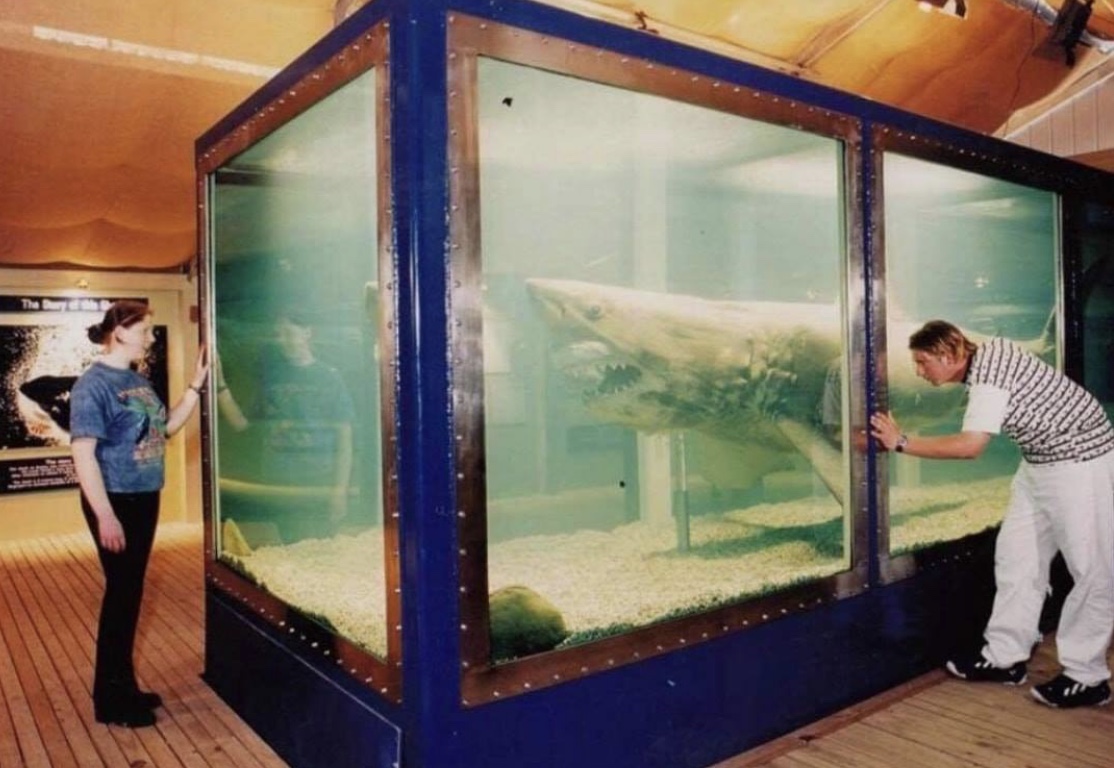
Deep inside a crumbling wildlife park in rural Victoria, a group of urban explorers stumbled upon something that shouldn’t have been there. Past the collapsed sheds and rusting enclosures, through a dark half-ruined building, they found a sight so surreal it would spread worldwide within days. A 16-foot great white shark, suspended in cloudy preservative, its vast silhouette drifting behind cracked glass in an abandoned tank. When their torchlight cut across the murk, the liquid glowed an eerie green, revealing the full outline of the creature within.
Wildlife Wonderland in Bass, Victoria, had been shut down since 2012, its gates locked and its future uncertain. Authorities had relocated more than 130 animals when the park lost its operating licenses, but one specimen remained behind, forgotten in a sealed indoor tank. Years passed with no one knowing she was still there, suspended in toxic formaldehyde while everything around her decayed.
That changed when YouTuber Luke McPherson ventured through the derelict property in 2018, camera in hand. His torch beam caught the shape first, a pale mass suspended in green-tinged liquid, before the outline sharpened into the unmistakable form of a great white shark. McPherson uploaded the footage, and within days it exploded online. His video drew more than 17 million views, pulling global attention toward the forgotten park and the preserved shark still floating inside it. People couldn’t look away from the haunting image of this apex predator trapped in time, surrounded by debris in a building falling apart around her.
Caught in Nets, Killed for Safety
Before she became known as Rosie, this great white swam the waters off Portland, South Australia. Her story began in 1997 when she became entangled in tuna fishing nets, thrashing with such violence that anyone attempting a rescue would have risked their life. Great white sharks are powerful, unpredictable animals, and when trapped, they become even more dangerous.
Biology compounded the tragedy. When great whites experience extreme stress, their blood begins to overheat, a fatal physiological response that leaves no survivors. Fishermen faced an impossible choice: watch her die slowly in agony or end her suffering immediately. They chose mercy, using a pole with a bullet to deliver instant death through her skull.
Her body was stored in a freezer while educational institutions across Australia expressed interest in acquiring such a rare specimen. Young female great whites in near-perfect condition rarely become available for study or display. Before she could reach her destination, authorities intercepted the transport for an autopsy when concerns arose that she might have consumed the remains of a missing woman from the South Australian coast. Examination found no trace of human remains, and her journey continued.
From Ocean Predator to Wildlife Park Curiosity
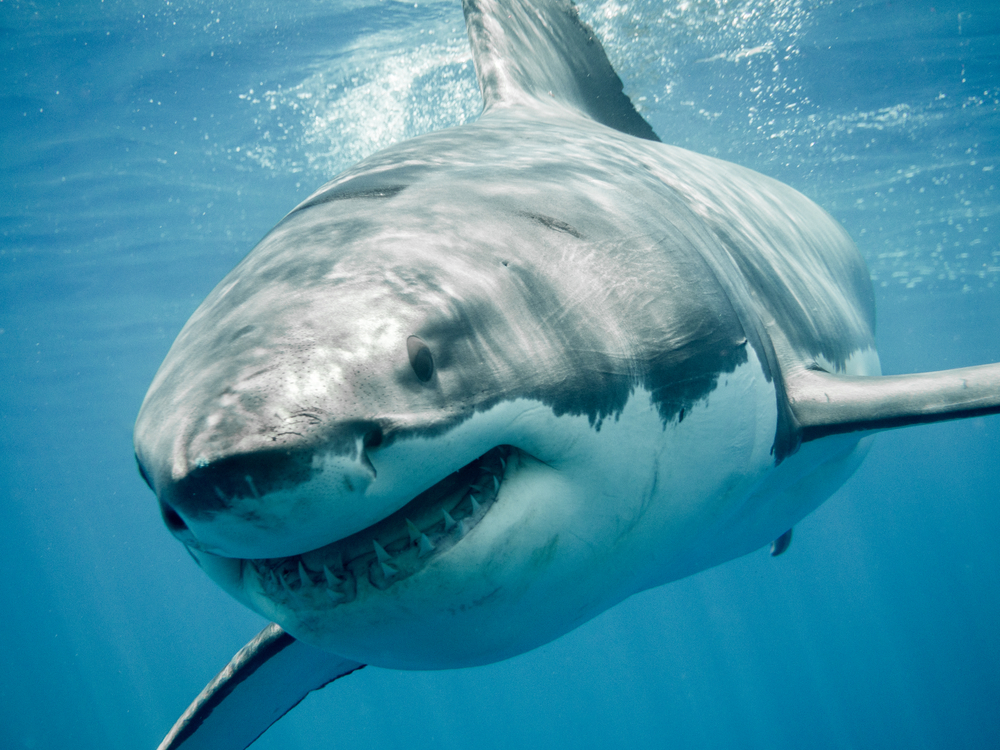
Wildlife Wonderland won the bid to purchase Rosie in 1998, reportedly spending around £246,880 to secure her. A refrigerated truck carried her body 900 miles to Victoria, where she was lowered into a massive custom-built tank filled with formaldehyde. For years she became one of the park’s most popular attractions, drawing visitors who marveled at her size and the strange beauty of seeing an apex predator frozen mid-swim.
But wildlife parks require proper licensing, meticulous record-keeping, and constant attention to animal welfare. Wildlife Wonderland failed on multiple counts. In 2012, authorities shut down operations after discovering the park had been operating without the necessary permits. Animal welfare concerns added urgency to the closure. More than 130 living animals were seized and relocated to appropriate facilities, operators were evicted from the property, and the grounds were left to nature and decay.
Rosie, already dead and preserved, didn’t qualify for relocation. She remained in her tank while the buildings around her collapsed, the paint peeled, and the fences fell. Pumps continued circulating the formaldehyde, keeping her from rotting even as everything else succumbed to time. For six years she floated in darkness, unknown to anyone except a handful of former staff and the property owner.
Breaking In, Smashing Glass, Stealing Teeth
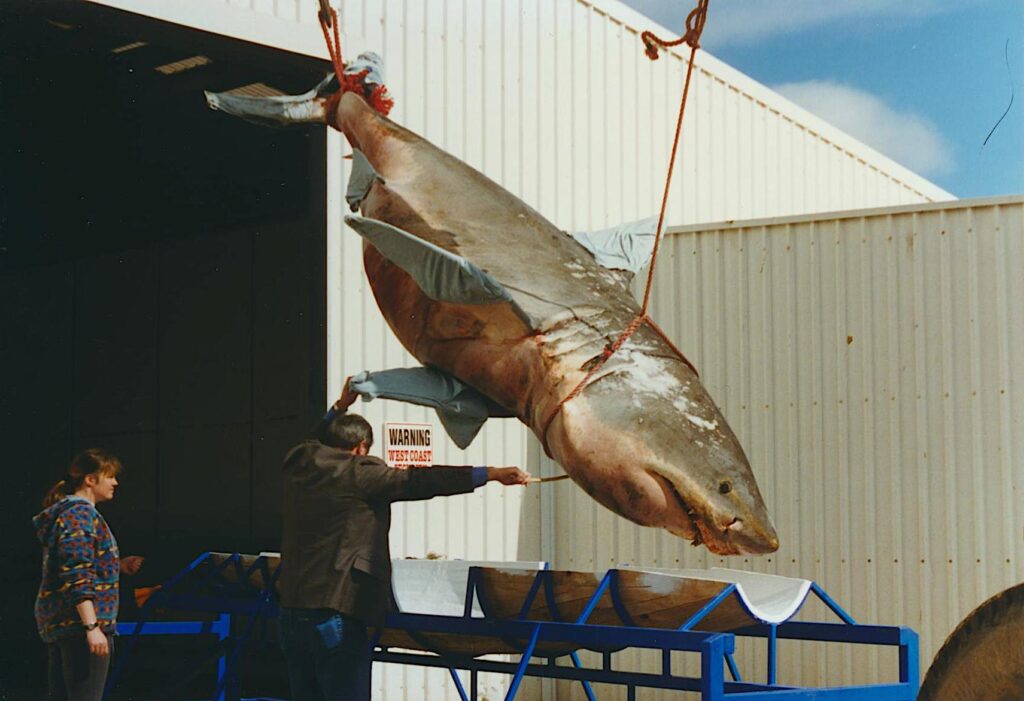
McPherson’s viral video didn’t just draw curiosity. Within weeks of the footage appearing online, trespassers descended on the abandoned park in numbers that overwhelmed any remaining security. People forced their way into the crumbling shed, determined to see Rosie for themselves or take home a piece of internet history.
What started as exploration quickly turned destructive. Someone pried open the tank’s roof hatch, exposing the highly toxic formaldehyde to open air. Another person hurled a discarded television straight into the tank, letting it sink into the cloudy chemical bath. Others threw rocks at the glass, trying to shatter it, apparently unconcerned about the consequences of releasing a shipping-container-sized volume of carcinogenic liquid.
Some attempted to steal her teeth as souvenirs, reaching into the tank with whatever tools they could find. Hedge trimmers became weapons against a dead shark’s mouth. Each act of vandalism threatened the structural integrity of the tank while destabilizing the formaldehyde, which had already become dangerously volatile after years without proper maintenance.
Tom Kapitany, who would later rescue Rosie, described the escalation with blunt disbelief: “People opened the tank up and were using hedge trimmers to try break teeth out of Rosie’s mouth. It’s a 20ft long tank the size of a shipping container filled with formaldehyde and kids were throwing rocks at the glass. Had they broken the glass, they would have been killed.”
As damage mounted and the situation became increasingly hazardous, the landowner faced a grim decision. Public liability concerns left little room for alternatives. Plans were made to destroy Rosie altogether, preventing further break-ins by eliminating what drew people there in the first place. Her story appeared destined to end in a landfill.
Tom Kapitany Steps In Before Destruction
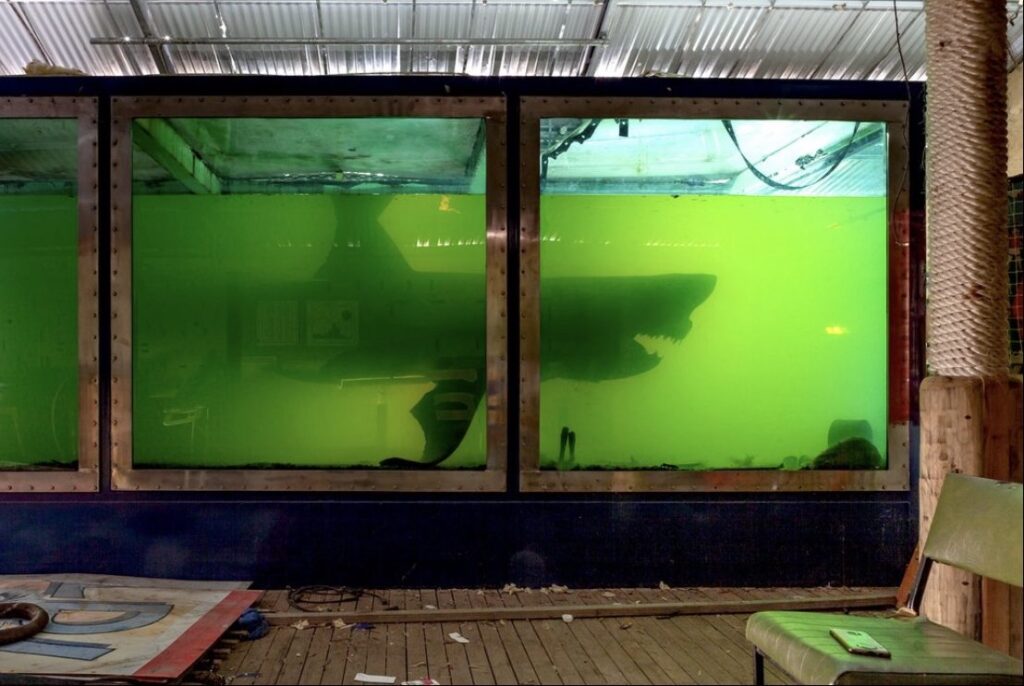
Tom Kapitany first saw Rosie seven years before she went viral, during a 2012 tour of the abandoned theme park when he considered buying the property. Walking through the decaying buildings, he encountered the tank and the shark floating inside what he would later describe as a green, slimy prison. Although the property sale never materialized, the image stayed with him long after he left.
Kapitany built his life around unusual passions. A geologist, botanist, and entrepreneur, he owns Crystal World Exhibition Centre in Devon Meadows, about an hour outside Melbourne, where he displays crystals, fossils, and minerals. His childhood was spent in the bush, encouraged by a father who shared his love for nature’s oddities. As a boy, he collected strange specimens and even experimented with preserving snakes in jars of alcohol and formaldehyde.
When he learned in 2019 that Rosie faced destruction, his response was immediate. “It would be sacrilegious if she had been buried in landfill. Doesn’t everyone want a shark preserved in their backyard?” he explained.
Kapitany arranged for Rosie’s entire tank to be craned out of the collapsing shed, a delicate operation requiring careful handling of contaminated, unstable formaldehyde. As the extraction made national headlines, he hired 24-hour security to protect both the workers and the shark from interference. Moving a 20-foot tank filled with toxic chemicals through a deteriorating building while managing public attention required resources most people wouldn’t commit to a dead shark.
But Kapitany isn’t most people. His motivations never centered on profit or spectacle. He simply couldn’t bear the thought of such a rare specimen ending up as garbage.
Cleaned, Restored, and Given New Life
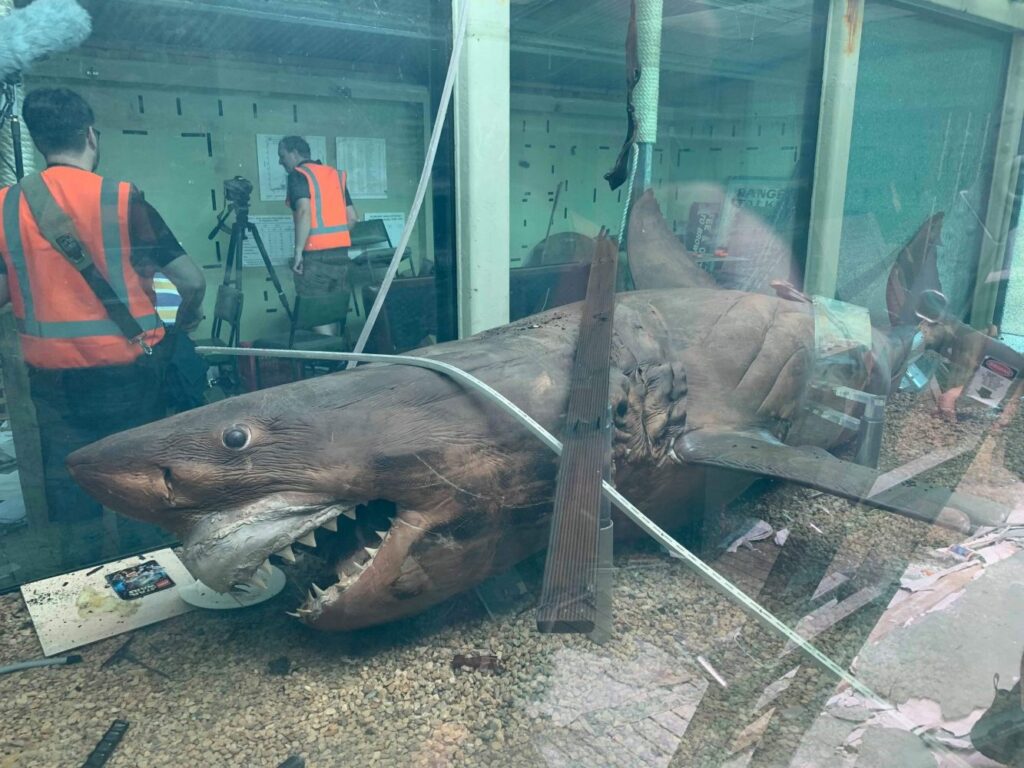
Once Rosie arrived at Crystal World, Kapitany faced the task of making her presentable and safe. Years of neglect, vandalism, and exposure to destabilized chemicals had taken their toll. He disposed of the contaminated formaldehyde and cleaned the tank thoroughly before refilling it with approximately 5,000 liters of glycerol, a natural preservative that prevents decay without releasing harmful vapors.
Glycerol allowed visitors to see Rosie clearly for the first time in years. No more murky green sludge obscuring her form. No more toxic fumes requiring respirators and hazmat suits. Just a perfectly preserved great white shark, restored to something approaching dignity.
She now rests in the Crystal World car park while Kapitany awaits the necessary permits to construct a purpose-built viewing gallery designed for school groups and educational visits. Her presence has attracted visitors from Brazil, India, Canada, and across Australia. A dedicated Facebook page has amassed 52,000 followers, forming what Kapitany calls a supportive, like-minded community of people fascinated by natural history and marine biology.
Some of the items stolen from her old exhibit at Wildlife Wonderland have been anonymously returned to Kapitany over the years. He plans to include them in the future gallery alongside shark fossils and relics from across Australia, creating a comprehensive educational display about great whites and ocean conservation.
An Educational Legacy, Not a Money Grab
Kapitany refuses to charge admission to see Rosie, despite the thousands of dollars he’s invested in her rescue, restoration, and maintenance. “We don’t charge people to see Rosie. It was never about making money out of her. If anything she’s cost me a significant amount of money,” he said.
His hope extends beyond simply preserving a rare specimen. He wants Rosie’s story to change how people think about great white sharks and their ocean habitat. “[I hope] it will help people understand that these are beautiful creatures which have lives and we shouldn’t destroy their home.”
Great whites remain protected as an endangered species, making specimens like Rosie invaluable for education and research. Few people will ever encounter a great white in the wild, and fewer still will see one this close, this clear, this perfectly preserved. Her existence allows scientists, students, and curious visitors to study an apex predator without endangering themselves or the sharks.
Rosie’s tank receives regular cleaning and monitoring to ensure her preservation remains stable. Kapitany maintains her with the same care he’d give to any living exhibit, checking fluid levels, inspecting the glass, and ensuring everything functions properly. She’s no longer abandoned, no longer forgotten, no longer at risk of destruction.
From ocean to freezer, from exhibition to ruin, from internet spectacle to renewed preservation, Rosie’s journey remains one of the strangest tales of a great white shark that refused to disappear. She floats now in stable conditions, visited by thousands each year, cared for by a man who saw value where others saw liability. Her second life continues in a car park in Victoria, where people travel from around the world to stand before her and remember that even in death, nature deserves respect.
Loading...

